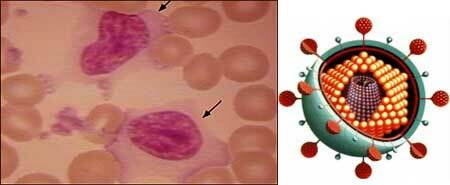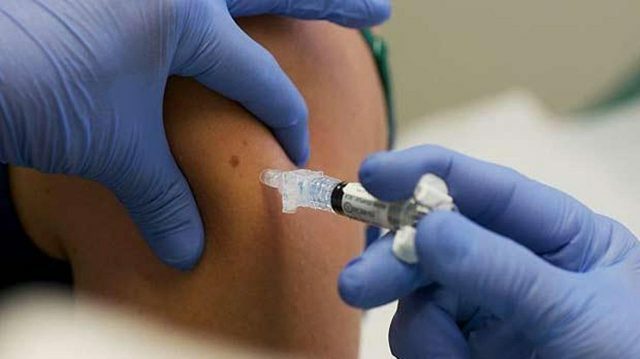The Epstein-Barr virus( VEB infection) is one of the newest terms in medicine. And although 90% of the population is infected with EBV infection, there is still no complete information on the effect of the virus on the body.
You can live a lifetime without even suspecting his presence, or learn about infection when a serious illness is detected.
So, the Epstein-Barr virus: a fashion diagnosis, pulling out money for expensive drugs, or is it really a serious problem requiring increased attention?
Contents
- 1 Epstein-Barr virus - what is it?
- 2 Epstein-Barr virus-induced diseases
- 3 Varicides of the EBV infection
- 4 Symptoms of the Epstein-Barr virus
- 5 Epstein-Barr virus treatment, preparations
- 5.1 Forecast
Epstein-Barr virus - what is it?
The Epstein-Barr virus is a microorganism from the herpes virus family, called the 4 type of herpes. The virus is introduced into B-lymphocytes, but does not destroy them, but transforms them.
VEB can be compared to a parasite that does not kill its carrier( lymphocytes), but only uses it for more insidious purposes. Infection affects not only the immune system, but also damages the central nervous system and is able to penetrate all organs.

Herpes simplex virus type 4 is distributed exclusively among people( including patients with asymptomatic forms of infection) in the following ways:
- Airborne - when saliva or mucus from the nasopharynx of the patient enters;
- Sexual and blood transfusion - during sexual intercourse or blood transfusion / bone marrow transplantation from an infected person;
- Intrauterine - a woman's EBV disease during pregnancy leads to the formation of malformations in the fetus( earlier contact with the infection does not pose such a serious threat to the fetus).
Features of infection with EBV:
- Infection usually occurs in infancy( with a mother's kiss).
- Although VEB is contagious, infection occurs only with close contact of an infected person and a healthy one. That's why the disease is called a disease of kisses.
- Typical symptomatology of the Epstein-Barr virus in children is frequent colds and inflammation of the upper respiratory tract( sinusitis, tonsillitis, rhinitis), difficult to treat.
- In adults, the presence of EBV infection can be suspected with constant fatigue, breakdown in the morning. It is the herpetic infection that most often provokes chronic fatigue syndrome.
Recent medical studies have shown that the Epstein-Barr virus can trigger processes in the body that lead to severe and sometimes incurable diseases: diabetes, rheumatoid arthritis, autoimmune thyroiditis.
The virus, initially affecting the lymphoid tissue( B-lymphocytes) and the epithelial cells of the salivary glands and the nasopharyngeal region, can reproduce at a minimum and for a long time not exhibit external symptoms( latent flow).
The impetus for active reproduction is any condition that causes immune weakness and an inadequate immune response( autoimmune reaction).Imbalance of the immune system links - decrease in T-lymphocyte level and increase in B-lymphocytes - subsequently provokes serious disorders in the division and maturation of cells of various organs and often leads to oncology .
EBV infection can occur:
- Acute and chronically;
- With typical and hidden( asymptomatic form) manifestations, lesions of different internal organs;
- By mixed type - most often in combination with cytomegalovirus.
Diseases provoked by the Epstein-Barr virus
 EBV infection manifests itself in three scenarios: primary infection against the background of immunodeficiency, a sluggish current infection or activation of latent EBV infection with a sharp decrease in immune defense( surgery, colds, stress, etc.).As a result, the virus can provoke:
EBV infection manifests itself in three scenarios: primary infection against the background of immunodeficiency, a sluggish current infection or activation of latent EBV infection with a sharp decrease in immune defense( surgery, colds, stress, etc.).As a result, the virus can provoke:
- infectious mononucleosis;
- Hodgkin's lymphoma( lymphogranulomatosis) and non-Hodgkin's her forms;
- nasopharyngeal carcinoma;
- herpes skin and mucous membranes - herpetic eruptions on the lips, shingles, herpetic sore throat, genital herpes;
- chronic fatigue syndrome;
- Burkitt's lymphoma is a cancerous tumor that affects the jaw, kidneys, lymph nodes of the retroperitoneal space and the ovaries;
- oncology of the digestive tract;
- leukoplakia - the appearance of white spots on the skin and mucous membranes, while their high bleeding is noted;
- severe damage to the liver, heart and spleen;
- autoimmune diseases - lupus erythematosus, rheumatoid arthritis, multiple sclerosis;
- blood diseases - malignant anemia, leukemia, thrombocytopenic purpura.
Varieties of EBV infection
The Epstein-Barr virus produces several specific proteins( antigens):
- The capsid( VCA) is an antigen to the inner protein content of the herpes virus;
- Membrane( MA) - protein agents directed to the envelope of a virus substance;
- Nuclear( EBNA) is an antigen that controls the reproduction of a virus and prevents its death.
In response to antigenic synthesis, the immune system produces antibodies to the Epstein-Barr virus, which serve as an indicator of the stage of the disease. Their presence in the blood and quantity varies depending on the stage of the disease:
In the absence of infection, - antibodies to herpes of type 4 IgM - less than 20 U / ml, IgG - less than 20 U / ml.
At an early stage of the disease, only antibodies to the Epstein-Barr virus capsid antigen( anti-VCA IgM over 40 U / ml) are detected. The maximum indicators are achieved for 1-6 weeks.from the onset of the disease, and their normalization takes 1-6 months. The presence of IgM in the blood indicates an active infection.
In the acute course of , antibodies to VCA IgM and VCA IgG appear. Caspid antibodies of IgG class with Epstein-Barr virus in the acute phase are positive and show more than 20 U / ml and reach a maximum value by 2 months from the onset of the disease, decrease in the process of recovery( may appear several more years).
The more acute the infection occurs during primary infection, the higher the anti-VCA IgG titer.
In the persistent stage of , all types of antibodies( VCA IgM, VCA IgG and EBNA IgG) are synthesized. The appearance of IgG-class antibodies to the nuclear protein antigen EBNA indicates the onset of regression of the disease and a speedy recovery. Their titre is increased by 3-12 months.disease and continues to be held on high numbers for several years.
In the absence of painful symptoms, anti-EBNA IgG in the blood ascertain the fact of the previous disease, possibly in asymptomatic form.
Symptoms of the Epstein-Barr virus

The symptoms of infection with the Epstein-Barr virus, the duration of the course of the disease - both the form of the disease and the direction of the viral "shock" depends.
Primary infection can go asymptomatically to the phase of carriage, signs of viral presence are detected only when serological examination of the blood.
With erased flow, traditional treatment of ARVI in children with the Epstein-Barr virus does not bring a quick recovery.
In other cases, there is an acute disease with severe symptoms or a lingering current infection with a chronic pathological deviation. Sometimes a generalized form develops with severe damage to organs and systems.
Infectious mononucleosis
From infection to the appearance of the first signs of the disease takes 5 to 45 days. The main symptoms of mononucleosis:
- Catarrhal phenomena - looseness of the tonsils and hyperemia of the palatine arch( symptoms of angina), clear or purulent discharge from the nose, ulcerative stomatitis.
- Intoxication - since the first days of the disease, significant hyperthermia( above 38C), chills, joint pain, weakness. A similar pattern persists for 1-4 weeks.
- Enlarged lymph nodes - are found 7 days after the onset of the disease, painless and dense. Palpable in the neck: occipital, submandibular, axillary, sub- and supraclavicular.
- Enlarged liver - by 2 fingers( found when tapping) a week after the onset of the first signs of the disease. Accompanied by abdominal pain, lack of appetite, nausea, jaundice( yellow skin and sclera, discolored stool, dark urine).
- Enlargement of the spleen - a significant splenomegaly is accompanied by pain in the left side.
Recovery does not occur until 2-3 weeks. With a gradual improvement in well-being, periods of exacerbation of the disease can be observed. Periodic return of symptoms indicates a weak immunity. Recovery may last 1.5 years.
Chronic fatigue syndrome
A vivid example of the symptoms of a sluggish current EBV infection. Patients constantly complain of weakness, even after a full sleep. The temperature is up to 37.5 ° C for no apparent reason, the headache, muscle and joint pains are often perceived as a cold.
In this case, this state continues for a long time, and against a background of poor sleep and mood swings the exhausted organism reacts with depression or psychosis.
The working capacity of adults is also noticeably affected. Children have a marked decrease in memory, absent-mindedness and inability to concentrate.
Generalized viral infection of
Generalized infection with the virus occurs against a background of considerable immunity immunity. After an acute course of infectious mononucleosis,
- may develop severe pneumonia accompanied by respiratory failure;
- inflammation of the membranes of the heart( fraught with cardiac arrest);
- meningitis, encephalitis( threat of brain edema);
- toxic hepatitis and liver failure;
- rupture of the spleen;
- DIC-syndrome( intravascular coagulability of blood);
- lymph node involvement throughout the body.
Often generalization of EBV infection is accompanied by a bacterial attack, which leads to sepsis and is fraught with fatal consequences.
Treatment of the Epstein-Barr virus, preparations

No specific drugs have been created for the complete elimination of VEB.Treatment of the Epstein-Barr virus is reduced to weakening the infection, balancing the immune system and preventing complications. Drug therapy depends on the type of immune response to a viral attack and includes:
- Antiviral drugs - Granciclovir, Valaciclovir, Famciclovir, Acyclovir( least effective), course not less than 2 weeks;
- Interferons and immunoglobulins - most effective Reaferon;
- Thymus hormones( Timalin, Timogen) and immunomodulators( Decaris, Lycopid) - increase in T-lymphocyte level and decrease in B-cells);
- Corticosteroids( Prednisolone, Dexamethasone) and cytotoxic agents - with an autoimmune reaction.
Simultaneously, symptomatic treatment and antibiotic therapy with Sumamed or Cefazolinum( according to indications) is carried out. Necessarily to maintain a healthy sleep, full nutrition, refusal of alcohol and the exclusion of stressful situations.
The effectiveness of treatment is confirmed by the normalization of blood serology.
Forecast
For most patients who have Epstein-Barr virus, the prognosis is favorable. You just have to take good care of your health and do not delay with a doctor's consultation if symptoms of malaise appear.
- The main criterion for success and prevention of severe consequences is the maintenance of immunity at a sufficient level.



